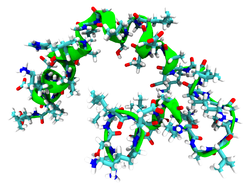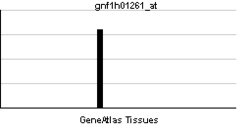- Dermcidin
-
Dermcidin 
Solution structure of dermcidin-1L.[1]Identifiers Symbols DCD; HCAP; AIDD; DCD-1; DSEP; MGC71930; PIF External IDs OMIM: 606634 HomoloGene: 89039 GeneCards: DCD Gene Gene Ontology Molecular function • manganese ion binding Cellular component • extracellular region Biological process • xenobiotic metabolic process
• defense response to bacterium
• defense response to fungusSources: Amigo / QuickGO RNA expression pattern 
More reference expression data Orthologs Species Human Mouse Entrez 117159 n/a Ensembl ENSG00000161634 n/a UniProt P81605 n/a RefSeq (mRNA) NM_053283 n/a RefSeq (protein) NP_444513 n/a Location (UCSC) Chr 12:
53.32 – 53.33 Mbn/a PubMed search [1] n/a Dermcidin is a protein that in humans is encoded by the DCD gene.[2][3] Dermcidin is an anti-microbial (antibiotic) peptide released by human sweat glands.
Contents
Function
Dermcidin is a secreted protein that is subsequently processed into mature peptides of distinct biological activities. The C-terminal peptide is constitutively expressed in sweat and has antibacterial and antifungal activities. The N-terminal peptide, also known as diffusible survival evasion peptide, promotes neural cell survival under conditions of severe oxidative stress. A glycosylated form of the N-terminal peptide may be associated with cachexia (muscle wasting) in cancer patients.[3]
References
- ^ PDB 2KSG; Jung HH, Yang ST, Sim JY, Lee S, Lee JY, Kim HH, Shin SY, Kim JI (May 2010). "Analysis of the solution structure of the human antibiotic peptide dermcidin and its interaction with phospholipid vesicles". BMB Rep 43 (5): 362–8. PMID 20510021.
- ^ Schittek B, Hipfel R, Sauer B, Bauer J, Kalbacher H, Stevanovic S, Schirle M, Schroeder K, Blin N, Meier F, Rassner G, Garbe C (Nov 2001). "Dermcidin: a novel human antibiotic peptide secreted by sweat glands". Nat Immunol 2 (12): 1133–7. doi:10.1038/ni732. PMID 11694882.
- ^ a b "Entrez Gene: DCD dermcidin". http://www.ncbi.nlm.nih.gov/sites/entrez?Db=gene&Cmd=ShowDetailView&TermToSearch=117159.
Further reading
- Todorov P, Cariuk P, McDevitt T, et al. (1996). "Characterization of a cancer cachectic factor.". Nature 379 (6567): 739–42. doi:10.1038/379739a0. PMID 8602222.
- Todorov PT, Deacon M, Tisdale MJ (1997). "Structural analysis of a tumor-produced sulfated glycoprotein capable of initiating muscle protein degradation.". J. Biol. Chem. 272 (19): 12279–88. doi:10.1074/jbc.272.19.12279. PMID 9139670.
- Cunningham TJ, Hodge L, Speicher D, et al. (1998). "Identification of a survival-promoting peptide in medium conditioned by oxidatively stressed cell lines of nervous system origin.". J. Neurosci. 18 (18): 7047–60. PMID 9736629.
- Cunningham TJ, Jing H, Wang Y, Hodge L (2000). "Calreticulin binding and other biological activities of survival peptide Y-P30 including effects of systemic treatment of rats.". Exp. Neurol. 163 (2): 457–68. doi:10.1006/exnr.2000.7390. PMID 10833321.
- Cunningham TJ, Jing H, Akerblom I, et al. (2002). "Identification of the human cDNA for new survival/evasion peptide (DSEP): studies in vitro and in vivo of overexpression by neural cells.". Exp. Neurol. 177 (1): 32–9. doi:10.1006/exnr.2002.7979. PMID 12429208.
- Strausberg RL, Feingold EA, Grouse LH, et al. (2003). "Generation and initial analysis of more than 15,000 full-length human and mouse cDNA sequences.". Proc. Natl. Acad. Sci. U.S.A. 99 (26): 16899–903. doi:10.1073/pnas.242603899. PMC 139241. PMID 12477932. http://www.pubmedcentral.nih.gov/articlerender.fcgi?tool=pmcentrez&artid=139241.
- Porter D, Weremowicz S, Chin K, et al. (2003). "A neural survival factor is a candidate oncogene in breast cancer.". Proc. Natl. Acad. Sci. U.S.A. 100 (19): 10931–6. doi:10.1073/pnas.1932980100. PMC 196905. PMID 12953101. http://www.pubmedcentral.nih.gov/articlerender.fcgi?tool=pmcentrez&artid=196905.
- Zhang Z, Henzel WJ (2005). "Signal peptide prediction based on analysis of experimentally verified cleavage sites.". Protein Sci. 13 (10): 2819–24. doi:10.1110/ps.04682504. PMC 2286551. PMID 15340161. http://www.pubmedcentral.nih.gov/articlerender.fcgi?tool=pmcentrez&artid=2286551.
- Suzuki Y, Yamashita R, Shirota M, et al. (2004). "Sequence comparison of human and mouse genes reveals a homologous block structure in the promoter regions.". Genome Res. 14 (9): 1711–8. doi:10.1101/gr.2435604. PMC 515316. PMID 15342556. http://www.pubmedcentral.nih.gov/articlerender.fcgi?tool=pmcentrez&artid=515316.
- Monitto CL, Dong SM, Jen J, Sidransky D (2005). "Characterization of a human homologue of proteolysis-inducing factor and its role in cancer cachexia.". Clin. Cancer Res. 10 (17): 5862–9. doi:10.1158/1078-0432.CCR-04-0435. PMID 15355918.
- Gerhard DS, Wagner L, Feingold EA, et al. (2004). "The status, quality, and expansion of the NIH full-length cDNA project: the Mammalian Gene Collection (MGC).". Genome Res. 14 (10B): 2121–7. doi:10.1101/gr.2596504. PMC 528928. PMID 15489334. http://www.pubmedcentral.nih.gov/articlerender.fcgi?tool=pmcentrez&artid=528928.
- Lai YP, Peng YF, Zuo Y, et al. (2005). "Functional and structural characterization of recombinant dermcidin-1L, a human antimicrobial peptide.". Biochem. Biophys. Res. Commun. 328 (1): 243–50. doi:10.1016/j.bbrc.2004.12.143. PMID 15670776.
- Rieg S, Steffen H, Seeber S, et al. (2005). "Deficiency of dermcidin-derived antimicrobial peptides in sweat of patients with atopic dermatitis correlates with an impaired innate defense of human skin in vivo.". J. Immunol. 174 (12): 8003–10. PMID 15944307.
- Watchorn TM, Dowidar N, Dejong CH, et al. (2006). "The cachectic mediator proteolysis inducing factor activates NF-kappaB and STAT3 in human Kupffer cells and monocytes.". Int. J. Oncol. 27 (4): 1105–11. PMID 16142329.
- Baechle D, Flad T, Cansier A, et al. (2006). "Cathepsin D is present in human eccrine sweat and involved in the postsecretory processing of the antimicrobial peptide DCD-1L.". J. Biol. Chem. 281 (9): 5406–15. doi:10.1074/jbc.M504670200. PMID 16354654.
- Lowrie AG, Wigmore SJ, Wright DJ, et al. (2006). "Dermcidin expression in hepatic cells improves survival without N-glycosylation, but requires asparagine residues.". Br. J. Cancer 94 (11): 1663–71. doi:10.1038/sj.bjc.6603148. PMC 2361319. PMID 16685272. http://www.pubmedcentral.nih.gov/articlerender.fcgi?tool=pmcentrez&artid=2361319.
- Ewing RM, Chu P, Elisma F, et al. (2007). "Large-scale mapping of human protein-protein interactions by mass spectrometry.". Mol. Syst. Biol. 3 (1): 89. doi:10.1038/msb4100134. PMC 1847948. PMID 17353931. http://www.pubmedcentral.nih.gov/articlerender.fcgi?tool=pmcentrez&artid=1847948.
- Frum R, Busby SA, Ramamoorthy M, et al. (2007). "HDM2-binding partners: interaction with translation elongation factor EF1alpha.". J. Proteome Res. 6 (4): 1410–7. doi:10.1021/pr060584p. PMID 17373842.
- Lee Motoyama JP, Kim-Motoyama H, Kim P, et al. (2007). "Identification of dermcidin in human gestational tissue and characterization of its proteolytic activity.". Biochem. Biophys. Res. Commun. 357 (4): 828–33. doi:10.1016/j.bbrc.2007.03.112. PMID 17448443.
External links
Antimicrobial cationic peptides Other, human Other, nonhuman Categories:- Human proteins
- Chromosome 12 gene stubs
- Dermatology stubs
- Antimicrobial peptides
Wikimedia Foundation. 2010.
